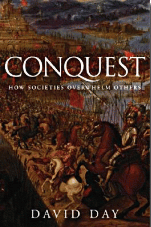
Conquest: How Societies Overwhelm Others
by David Day
For European explorers of new worlds, claiming land was easy enough. As David Day writes, it was as simple as planting a flag, cutting a tree branch, or collecting a cup of soil to take home. Sometimes it was even easier: the Spaniard Vasco Núñez de Balboa, when he became the first European to see the Pacific from its eastern shore in 1513, simply waded a few feet into the ocean and laid claim to all the land it touches.
Keeping the land has always been more difficult. Day’s book examines what he calls the “supplanting society,” arguing that no matter the nation, the methods used to take new land and make it home are quite similar. More significantly – particularly for a world that defines itself in terms of national boundaries, and by eras termed “colonial” and “post-colonial” – is Day’s argument that the process is essentially unending: “The history of most societies can be best understood when they are seen as part of a never-ending struggle, in a world of shifting boundaries, to make particular territories their own.” Day, an Australian historian, thus parallels his detailed historical retellings of European land-grabs in the Americas and Africa and Japan’s colonization of Korea and Hokkaido with more recent or ongoing struggles for homelands: by Palestinians in the Middle East, the Kurds in Iraq and Turkey.
As Day tells it, the problems for European explorers began almost immediately after the flags – or whatever markers – were planted. Vasco Da Gama dotted coasts with crosses and stone pillars, to aid the navigation of future Portuguese explorers and to let everyone else know who was there first, but native people would often simply knock them over. Dutchman Dirk Hartog had better luck putting up an inscribed pewter plate to mark West Australia as New Holland-the plate lasted decades, even if New Holland wasn’t made to last.
Whatever the method, the legal claim of a marker alone satisfied very few – societies required moral justification, Day writes. Some sought the consent of natives, however incompletely understood. Others sought to civilize them, and still others simply pushed them out of the way, dismissing them as incorrigible savages. On the latter point, Day quotes one Cherokee summing up the history of his people, with devastating simplicity at the dedication of the American Indian Museum in Washington, as “five centuries of being ‘shoved around and killed.’” Genocide in the service of claiming land, by Day’s count, is much older than its recent coinage would suggest.
Moral and legal claims weren’t sufficient either – the most vexing requirement is what Day calls the “de facto” claim to land, which societies try to achieve by map-making and naming, conquering and defending, settling and cultivating, and telling “foundation stories.” Day richly describes the attempts of several societies to pursue these ends: William the Conquerer’s swift construction of castles in England; Napoleon’s commissioning a 22-volume tome on Egypt; Thomas Jefferson dispatching Lewis and Clark; the Greeks and the Romans each attaching their story to the city now called Istanbul.
Though of course today’s maps are far more fixed and settled than those of centuries ago, Day’s depiction of societies in flux and under threat makes for a desperate and necessarily difficult world. But much as Day recommends we try, perhaps we couldn’t have it any other way. Day cites novelist Vance Palmer, who, during World War II, noted that without battles, a country like Australia, blessed with well-defined borders, still had “no monuments to speak of, no dreams in stone, no Guernicas, no sacred places. We could vanish almost without a trace.”
Excerpt: “Among the early European explorers, the Dutch were the most concerned with using maps to describe their discoveries and thereby to lay claim to them. While maps were originally sketched so that officials back home could more easily visualize the extent of their discoveries, the Dutch in North America soon were being instructed to draw up ‘perfect maps and descriptions’ of the lands they discovered. The resulting maps were more than a mere account of the Dutch discovery but were themselves ‘a critical sign of possession.'”
Further Reading: The Great Experiment: The Story of Ancient Empires, Modern States, and the Quest for a Global Nation and Empire: The Rise and Demise of the British World Order and the Lessons for Global Power




Send A Letter To the Editors